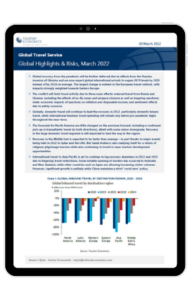Travel and Tourism: Global Highlights & Risks

Global recovery from the pandemic will be further deferred due to effects from the Russian invasion of Ukraine and we now expect global international arrivals to regain 2019 levels by 2025 instead of by 2024 on average. The largest change is evident in the European travel outlook, with impacts strongly weighted towards Eastern Europe. The conflict will limit travel activity due to three main effects: reduced travel from Russia and Ukraine, including the effects of no-fly zones and airspace closures as well as lingering sanctions; wider economic impacts of sanctions on inflation and disposable income; and sentiment effects due to safety concerns.
What you will learn:
- Globally, domestic travel will continue to lead the recovery in 2022, particularly domestic leisure travel, while international business travel spending will remain way below pre-pandemic highs throughout the near-term.
- The forecasts for North America are little changed on the previous forecast, including a continued pick-up in transatlantic travel (in both directions), albeit with some minor downgrade.
- Recovery in the Middle East is expected to be faster than average – in part thanks to major events being held in 2022 in Qatar and the UAE.
Tags:
Related Services

Post
Uncertainty is the biggest threat to growth this year
We have downgraded our forecasts for Australia due to the major disruptions to the global economy caused by changes to US trade policy.
Find Out More
Post
Commodity price forecasts cut as tariffs weigh on demand
Most commodity price forecasts are cut due to tariffs except for gold and battery metals, which show resilience amid global market shifts.
Find Out More